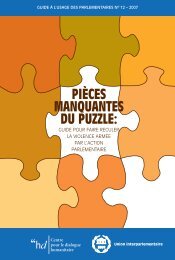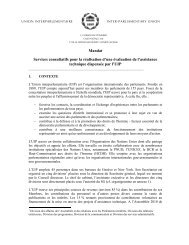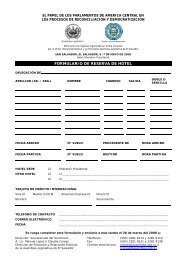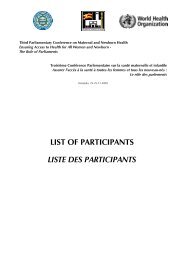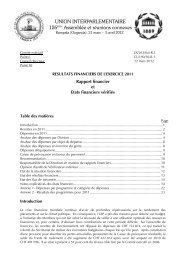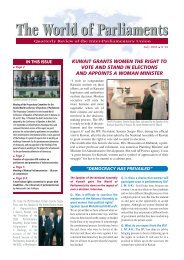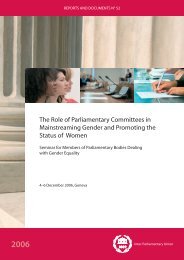MISSING PIECES - Inter-Parliamentary Union
MISSING PIECES - Inter-Parliamentary Union
MISSING PIECES - Inter-Parliamentary Union
Create successful ePaper yourself
Turn your PDF publications into a flip-book with our unique Google optimized e-Paper software.
ANNEX 8<br />
will take place; and when each activity is due to be completed. This will<br />
make it easier to determine whether the NAP is being implemented effectively<br />
or at all. Importantly, a timeframe (typically five years) and budget<br />
must also be determined.<br />
The initial plan may be limited due to a lack of the information necessary<br />
to develop a comprehensive strategy. Nevertheless, this may be more<br />
useful and appropriate than waiting until all the information necessary<br />
for a truly comprehensive NAP is collected, as this can be a costly exercise<br />
in terms of time and money, and by the time such information is collected,<br />
it may have ceased to be relevant or accurate. For this reason, NAPs should<br />
be constantly evolving to respond to changing circumstances. In some<br />
cases, an Implementation and Verification Plan will be developed once<br />
the NAP has been finalised, to ensure that NAP activities are monitored<br />
and adjusted where necessary.<br />
Each NAP will have to respond to particular circumstances. In Haiti,<br />
for instance, the main issue is urban gang violence in a context of weak<br />
state capacity where the communities will be called in to help manage<br />
the problem. The Haitian ‘National Strategy for Disarmament, Violence<br />
Reduction and Community Security’ (December 2006), therefore, calls<br />
for diagnostic studies and Community Action Plans to be developed for<br />
seven urban neighbourhoods initially, with a view to developing such<br />
plans for a total of 16 areas. A budget has been allocated to the development<br />
of these action plans, and the Strategy stipulates that each Community<br />
Action Plan will contain details of the violence reduction needs according<br />
to four dimensions of intervention: security; infrastructure; services<br />
and human development.<br />
Parliamentarians can assist in the development of NAPs and the mapping<br />
phase in particular. They are well positioned to help raise awareness<br />
of the process and communicate with their constituents regarding their<br />
participation in the survey process and its importance in obtaining an<br />
accurate picture of the small arms problem and its impact. Additionally,<br />
parliamentarians have access to information regarding which government<br />
departments and enforcement agencies have a role to play in national arms<br />
control, and their capacity to implement activities under an NAP. Furthermore,<br />
parliamentarians can assist in the process of ensuring that national<br />
firearms legislation is adapted to reflect NAP priorities identified through<br />
the mapping exercise.<br />
Regional cooperation will also be important to ensure the sustainability<br />
of an effective NAP and to avoid displacing the problem into neighbouring<br />
185



